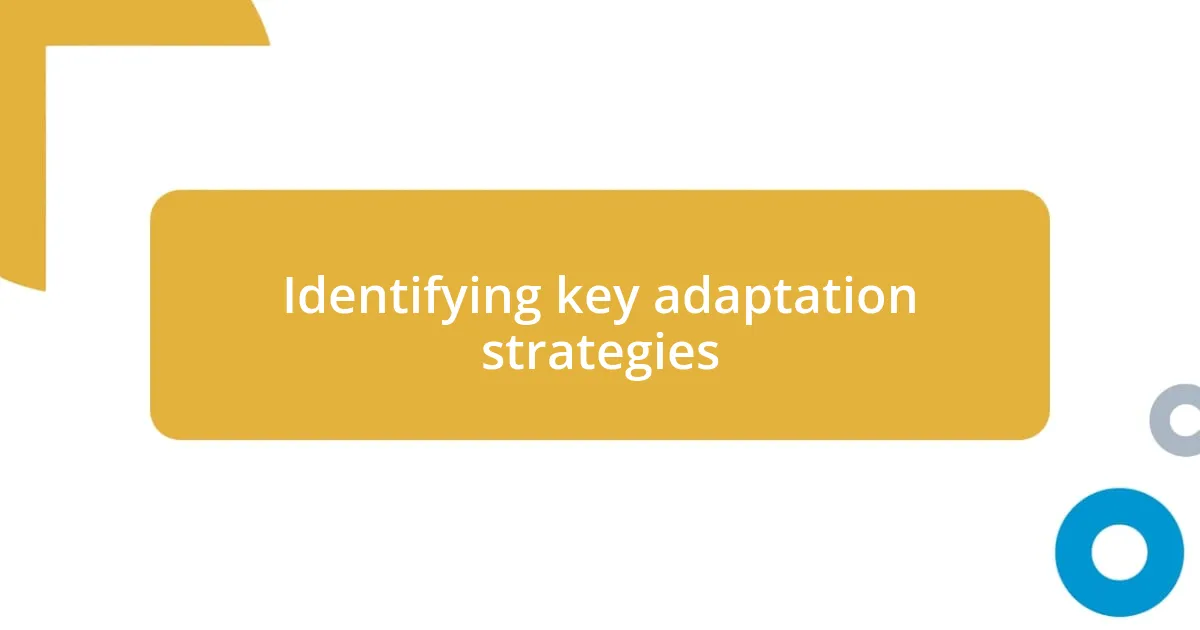Key takeaways:
- Understanding algorithm changes can lead to opportunities for innovation and deeper audience engagement.
- Proactive content audits and diverse formats are essential for adapting to shifts in performance and keeping content relevant.
- Continuous monitoring and analysis of audience metrics help uncover deeper narratives and inform content strategies.
- Staying updated with industry trends and embracing feedback fosters growth and connection with the audience.

Understanding algorithm changes
Understanding algorithm changes is crucial in today’s digital landscape. I remember the first time I noticed a significant shift in the usual patterns of my online content. It felt like a well-rehearsed dance that suddenly changed tempo; confusion set in as I questioned whether I’d misstepped or if the algorithm had simply decided to switch partners.
When algorithms shift, it’s often because the companies behind them are responding to how users interact with content. I’ve found that taking a moment to analyze the direction and intent behind these changes can be enlightening. Has anyone else felt that moment of panic when traffic drops overnight? That was me, feeling the weight of uncertainty, only to realize that adapting could lead to new opportunities.
These changes can feel overwhelming, but they also offer a chance to innovate and refine our strategies. During one particularly challenging adjustment, I chose to focus on engaging with my audience more authentically. This not only helped me understand the new algorithm better but also deepened my connection with my readers. It’s all about finding that balance—how do you stay relevant without losing your unique voice?

Recognizing impacts on performance
Recognizing when algorithm changes affect performance can be nerve-wracking, especially if you’re deeply invested in your content. I recall a period when my website traffic took a nosedive right after an algorithm update. It was painful to see numbers drop that had previously seemed stable. Through that experience, I learned to monitor analytics closely, identifying patterns and discrepancies that might signal a change in how my content was being perceived.
The emotional impact of these shifts can be profound. I remember waking up to find my engagement rates plummeting and feeling a wave of anxiety wash over me. Was my hard work in vain? However, after digging into the data, I discovered that the algorithm was prioritizing different forms of content. This prompted me to experiment with video snippets, infographics, and even interactive elements. Recognizing these shifts allowed me to pivot my approach and recapture my audience’s attention.
It’s essential to stay proactive. Instead of waiting for another drop in performance, I began conducting regular audits of my content strategy. This proactive stance not only prepared me for future algorithm changes but also made me feel more in control. The key is to view these updates not just as challenges, but as opportunities for growth and transformation.
| Impact on Performance | Response Strategy |
|---|---|
| Traffic drop | Analyze analytics to identify changes |
| Engagement rates decrease | Experiment with diverse content formats |
| Reduced visibility | Conduct regular content audits |

Identifying key adaptation strategies
Identifying effective adaptation strategies requires a blend of observation and intuition. I’ve realized that staying attuned to shifts in user engagement is crucial. One time, in the midst of an unexpected algorithm twist, I discovered that my audience responded better to personal storytelling rather than just informative posts. This revelation not only shaped my subsequent content but also reignited my passion for connecting with readers on a more personal level.
Here are some key strategies that have worked for me:
- Analyze Engagement Metrics: Regularly check which types of content resonate with your audience.
- Diversify Content Formats: Experimenting with videos and live Q&A sessions can amplify interaction.
- Solicit Feedback: Ask your audience what they want to see; this can guide your adaptation.
- Stay Educated: Keep learning about algorithm trends through webinars and articles.
- Create a Flexible Content Calendar: Prepare for potential algorithm changes by having diverse content plans ready to go.
When I embraced these strategies, I learned that every update was an opportunity to redefine my approach and strengthen my online community. It can be daunting, but looking for patterns in data has been a game-changer for me. Adaptation isn’t just survival; it’s about thriving in a constantly changing environment.

Implementing effective content adjustments
Implementing effective content adjustments requires a proactive mindset. I remember a time when I noticed my articles weren’t getting the traction they once did. Instead of shutting down or feeling defeated, I took a deep breath and asked myself: What do my readers truly want? This question led me to delve into my past content to determine which pieces sparked the most engagement. By analyzing feedback, I discovered some overlooked topics that resonated well with my audience, prompting me to refine my focus.
As I began diversifying my content, I found myself embracing new formats that felt intimidating at first. Remember my hesitation about creating video content? That first video was a huge leap outside my comfort zone, but to my surprise, the response was overwhelmingly positive! It reminded me that sometimes, the greatest breakthroughs come from taking risks and trying something different. Engaging with my audience through videos not only revitalized my connection with them but also added a fresh layer to my content strategy.
Regularly revisiting and adjusting my content has become second nature. I now approach each piece with the intention to adapt to ongoing algorithm changes. It’s a continuous journey, and I often ask myself how I can blend my authentic voice with trending topics. This honest reflection has instilled a sense of resilience in my work. My content isn’t just about following trends; it’s about creating meaningful connections that stand the test of time. How incredible is that?

Monitoring results and data analysis
Monitoring results and data analysis is more than just checking numbers; it’s about storytelling through metrics. I once found myself grappling with declining engagement, only to discover that my audience craved more relatable content. By dissecting my analytics, I pinpointed key trends that illuminated how my readers interacted with various posts. This experience taught me that behind every statistic lies a deeper narrative waiting to be uncovered.
I’ve learned that certain metrics can provide invaluable insights. For instance, I always pay close attention to the time spent on each post. When I noticed one specific article was held open longer than usual, it sparked my curiosity. Why did this happen? It turned out that my audience resonated with the emotional depth of that piece. This realization pushed me to create similar content that tugged at heartstrings.
Incorporating tools like Google Analytics into my workflow has been transformative. I realized early on that raw data is just the tip of the iceberg; the real insights lie in interpretation. Continuous analysis has allowed me to pivot faster when trends shift. Have you ever felt overwhelmed by data? I have. But now, I view these numbers as a guiding compass, directing me toward what truly matters to my community while refining my voice along the way.

Staying updated with industry trends
Staying current with industry trends is vital for anyone navigating the ever-evolving landscape of digital content. I often subscribe to industry newsletters and follow thought leaders on social media. Just recently, I stumbled upon a fascinating article that highlighted upcoming shifts in audience preferences. It sparked a realization in me about the importance of staying informed to ensure my content remains relevant.
Another approach that has worked wonders for me is participating in webinars and online conferences. I remember attending a session where experts discussed leveraging changes in algorithms for better visibility. It felt like a lightbulb moment. I left with fresh strategies that I immediately tested in my content creation, resulting in a noticeable uplift in engagement. Isn’t it exhilarating to learn in real-time from those at the forefront of the industry?
Lastly, I find that joining online communities can be incredibly insightful. These groups provide a space to exchange ideas and experiences with like-minded individuals. For example, I was once part of a forum where someone shared their success with a new content style. Inspired by their story, I decided to experiment with that format in my own work. The result? A surge in reader interaction. It’s amazing how connection and collaboration can fuel innovation, don’t you think?

Sharing lessons learned and insights
One significant lesson I’ve learned is the importance of experimentation. I recall a time when I decided to switch up my posting frequency to see how it affected audience engagement. At first, I was apprehensive; after all, would my loyal readers feel abandoned? To my surprise, increasing my posts filled with valuable insights resulted in a surge of interaction, validating my instinct that consistency can often outweigh infrequency. Have you ever hesitated to change a routine only to find that trying something new could lead to unexpected triumphs?
Moreover, embracing feedback has been a game-changer for me. There was a period when I hesitated to ask my audience for their opinions, fearing criticism. But once I opened that dialogue, I was overwhelmed by the positive response. One follower’s candid suggestion led me to cover topics I had never considered before, leading to an enriching experience for both myself and my readers. Isn’t it incredible how our audience can guide us toward refined content that resonates?
Lastly, I’ve discovered the power of adaptability in content creation. For example, during a sudden algorithm shift, I felt a pang of anxiety about losing my reach. Instead of panicking, I leaned into the discomfort, experimenting with new formats like videos and polls. The unexpected result was a genuine connection with my audience, reminding me that adaptation is not merely about surviving change; it’s about thriving in it. How often do we overlook the beauty of growth in moments of uncertainty?














